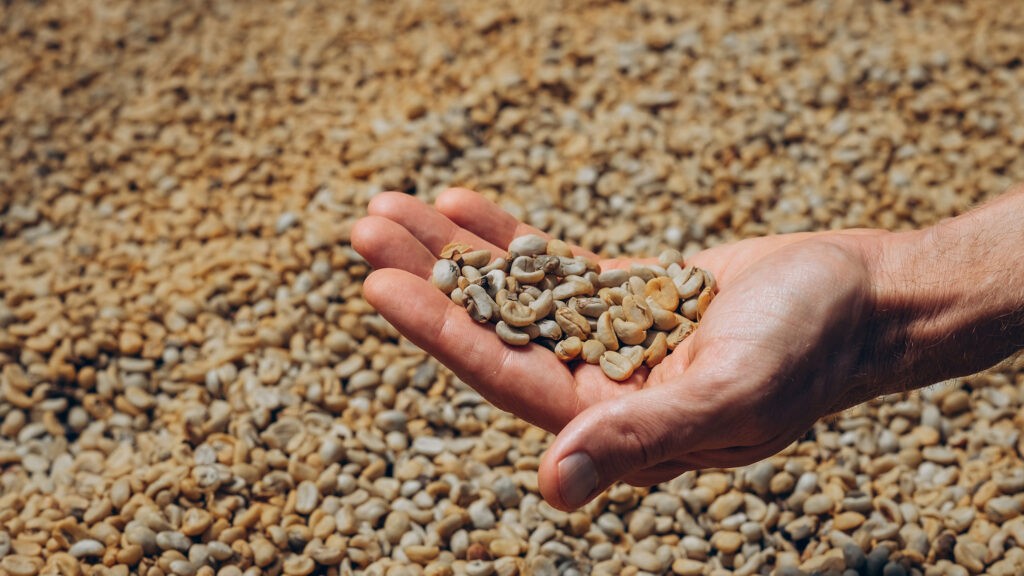Decaffeinated coffee offers a delightful alternative for those seeking the rich flavors and social experiences of coffee without the full jolt of caffeine; understanding how much caffeine remains is crucial. According to HOW.EDU.VN, even though the decaffeination process removes most of the caffeine, a small amount still exists. This detailed exploration examines the residual caffeine levels in decaf, its health implications, and the advanced processes used to decaffeinate coffee, helping you make informed choices about your coffee consumption and showcasing our expertise in food science and nutrition.
1. Decaf Coffee Compared to Regular Coffee: Caffeine Levels
When considering coffee consumption, it’s essential to understand the caffeine content in both decaf and regular varieties. The decaffeination process aims to significantly reduce caffeine levels, but it doesn’t eliminate them entirely.
1.1. Caffeine Content in Decaffeinated Coffee
Decaffeinated coffee typically contains a fraction of the caffeine found in regular coffee. By regulation, decaf coffee must have no more than 0.1% caffeine by weight. This usually translates to about 2–15 mg of caffeine per 8-ounce cup. The exact amount can vary based on the decaffeination method and the type of beans used.
1.2. Caffeine Content in Regular Coffee
In contrast, a standard 8-ounce cup of regular coffee contains around 95 mg of caffeine. This significant difference makes decaf a popular choice for individuals sensitive to caffeine or those who prefer to enjoy coffee later in the day without the stimulating effects.
1.3. Comparative Analysis
To put this into perspective, consider the following comparison:
| Coffee Type | Caffeine Content (per 8-ounce cup) |
|---|---|
| Regular Coffee | Approximately 95 mg |
| Decaffeinated Coffee | Approximately 2–15 mg |




This comparison clearly illustrates that decaf coffee offers a significantly reduced caffeine experience, making it a viable option for those managing their caffeine intake.
2. How Caffeine Fits into a Healthy Lifestyle
Managing caffeine intake is an essential aspect of maintaining a healthy lifestyle. Health authorities and experts offer guidelines to help individuals make informed decisions about their caffeine consumption.
2.1. Recommended Caffeine Intake
According to the U.S. Food and Drug Administration (FDA), most healthy adults can safely consume up to 400 mg of caffeine per day. This amount is generally considered safe and does not pose significant health risks for most individuals. However, individual tolerance levels can vary.
2.2. Factors Influencing Caffeine Tolerance
Several factors can influence how a person reacts to caffeine:
- Body Weight: Individuals with lower body weights may experience more pronounced effects from caffeine.
- Age: Older adults may process caffeine more slowly, leading to prolonged effects.
- Medications: Certain medications can interact with caffeine, either increasing or decreasing its effects.
- Health Conditions: People with heart conditions, anxiety disorders, or insomnia may need to be more cautious about their caffeine intake.
- Habitual Consumption: Regular coffee drinkers develop a tolerance to caffeine, requiring higher doses to achieve the same effects.
2.3. Recognizing Your Body’s Response
It’s essential to pay attention to how your body responds to caffeine. Common symptoms of excessive caffeine consumption include:
- Insomnia
- Anxiety
- Restlessness
- Irritability
- Rapid heartbeat
- Upset stomach
If you experience these symptoms, it may be necessary to reduce your caffeine intake.
2.4. Consulting Healthcare Professionals
For personalized advice, consulting a healthcare provider is always recommended, especially if you have underlying health conditions or concerns about caffeine intake. Healthcare professionals can provide tailored recommendations based on your health profile.
2.5. Caffeine in Other Foods and Beverages
Remember that caffeine is present in various foods and beverages, including:
- Tea
- Chocolate
- Energy drinks
- Some sodas
- Certain over-the-counter medications
Being mindful of all sources of caffeine is crucial for managing your overall intake effectively.
2.6. Benefits of Decaffeinated Coffee
Decaffeinated coffee allows you to enjoy the taste and social aspects of coffee without the high caffeine content. It also offers similar health benefits to regular coffee, such as antioxidant effects and reduced risk of certain diseases.
3. Health Benefits of Decaf Coffee
Decaffeinated coffee offers many of the same health benefits as regular coffee, making it an excellent choice for those looking to reduce their caffeine intake without sacrificing the positive effects associated with coffee consumption.
3.1. Rich in Antioxidants
Coffee beans are naturally rich in antioxidants, which help protect the body against damage from free radicals. The decaffeination process does not significantly reduce the antioxidant content, meaning decaf coffee still provides these valuable compounds. Antioxidants are crucial for reducing oxidative stress and lowering the risk of chronic diseases.
3.2. Reduced Risk of Type 2 Diabetes
Studies have shown that both regular and decaf coffee consumption can lower the risk of developing type 2 diabetes. Compounds in coffee, such as chlorogenic acid, are believed to improve insulin sensitivity and glucose metabolism.
3.3. Neuroprotective Effects
Coffee consumption is associated with a reduced risk of neurodegenerative diseases like Alzheimer’s and Parkinson’s. While caffeine contributes to these effects, other compounds in coffee also play a role. Decaf coffee can be a suitable alternative for those who want to protect their brain health without the stimulating effects of caffeine.
3.4. Improved Liver Health
Research suggests that coffee can promote liver health by reducing the risk of liver diseases, including cirrhosis and liver cancer. These benefits are observed in both regular and decaf coffee drinkers, highlighting the protective effects of coffee compounds beyond caffeine.
3.5. Cardiovascular Benefits
Some studies indicate that coffee consumption can improve cardiovascular health by reducing the risk of heart disease and stroke. Decaf coffee offers a heart-healthy alternative for individuals sensitive to caffeine’s effects on blood pressure and heart rate.
3.6. Enhanced Mood and Cognitive Function
While caffeine is known to enhance alertness and cognitive function, decaf coffee can also positively impact mood and cognitive performance. The social aspect of drinking coffee and the presence of other beneficial compounds contribute to these effects.
3.7. Longevity
Large-scale studies have found that coffee consumption, including decaf, is associated with increased longevity. These findings suggest that regular coffee consumption can contribute to a longer and healthier life.
3.8. Specific Studies and Findings
- UK Biobank Study: A significant study using data from the UK Biobank found that drinking 3 cups of any kind of coffee per day was associated with a 12% reduction in overall mortality. The study noted that similar associations were observed for instant, ground, and decaffeinated coffee.
- Harvard Studies: Multiple studies conducted by Harvard researchers have demonstrated that regular coffee consumption is linked to a reduced risk of various diseases, including type 2 diabetes, cardiovascular disease, and certain cancers.
3.9. Summary of Health Benefits
The following table summarizes the key health benefits of decaf coffee:
| Benefit | Description |
|---|---|
| Rich in Antioxidants | Helps protect the body against damage from free radicals, reducing oxidative stress and the risk of chronic diseases. |
| Reduced Risk of Type 2 Diabetes | Improves insulin sensitivity and glucose metabolism, lowering the risk of developing type 2 diabetes. |
| Neuroprotective Effects | May reduce the risk of neurodegenerative diseases like Alzheimer’s and Parkinson’s. |
| Improved Liver Health | Promotes liver health by reducing the risk of liver diseases, including cirrhosis and liver cancer. |
| Cardiovascular Benefits | May improve cardiovascular health by reducing the risk of heart disease and stroke. |
| Enhanced Mood | Positively impacts mood and cognitive performance, providing a sense of well-being. |
| Longevity | Associated with increased longevity, contributing to a longer and healthier life. |
4. How Decaf Coffee is Made: The Decaffeination Process
The process of making decaf coffee involves removing caffeine from green coffee beans while preserving their flavor and aroma. Various methods are used, each with its own advantages. All methods ensure that the final product meets safety standards and provides a satisfying coffee experience with minimal caffeine.
4.1. Overview of Decaffeination Methods
All decaffeinated coffee is made through chemistry! To remove around 97% of the caffeine found naturally in coffee, green coffee beans are warmed and soaked in liquid in one of four ways, all of which are equally safe and FDA compliant.
4.2. The European Method
The most common decaffeination method is the European Method, which involves the following steps:
- Steaming the Beans: Green coffee beans are steamed to open their pores, making the caffeine more accessible.
- Rinsing with a Solvent: The beans are rinsed with a liquid solvent, which bonds to and removes the caffeine. Common solvents include methylene chloride or ethyl acetate.
- Removing the Solution: The liquid solution, now containing the extracted caffeine, is removed from the beans.
- Extracting Caffeine: The caffeine is extracted from the rinsing solution for use in other products, such as energy drinks or pharmaceuticals. Nearly 100% of the rinsing solution is captured and reused to decaffeinate more coffee beans in a highly efficient, closed system.
- Drying and Roasting: The decaffeinated coffee beans are dried and roasted, just like caffeinated coffee beans. This process ensures that the beans develop their characteristic flavor and aroma.
4.3. Other Decaffeination Methods
-
Swiss Water Process: This method uses only water to remove caffeine. The green coffee beans are soaked in hot water, which extracts both caffeine and flavor compounds. The water is then passed through activated charcoal filters, which trap the caffeine molecules while allowing the flavor compounds to pass through. The caffeine-free water is then used to soak a new batch of beans, extracting only the caffeine and leaving the flavor intact.
-
CO2 Method: This method uses supercritical carbon dioxide (CO2) to remove caffeine. The green coffee beans are soaked in water and then placed in a high-pressure chamber filled with CO2. The CO2 selectively binds to the caffeine molecules, which are then removed, leaving the flavor compounds behind.
-
Triglyceride Method: This method involves soaking green coffee beans in coffee oils. The triglycerides in the oils selectively bind to caffeine molecules, which are then removed. The beans are then separated from the oils and processed further.
4.4. Ensuring Safety and Compliance
All decaffeination methods are carefully regulated to ensure the safety of the final product. Regulatory agencies, such as the U.S. Food and Drug Administration (FDA), set strict standards for the levels of residual solvents allowed in decaffeinated coffee. These standards ensure that the coffee is safe for consumption.
4.5. Impact on Flavor
While the decaffeination process can slightly alter the flavor of coffee, modern methods are designed to minimize these effects. Many coffee drinkers find that decaf coffee retains much of the flavor and aroma of regular coffee, making it a satisfying alternative.
4.6. Summary of Decaffeination Methods
The following table summarizes the key aspects of different decaffeination methods:
| Method | Solvent Used | Process Description |
|---|---|---|
| European Method | Methylene Chloride or Ethyl Acetate | Green coffee beans are steamed, rinsed with a solvent to remove caffeine, and then dried and roasted. The solvent is captured and reused. |
| Swiss Water Process | Water | Green coffee beans are soaked in hot water, which is then filtered through activated charcoal to remove caffeine. The caffeine-free water is used to soak a new batch of beans. |
| CO2 Method | Supercritical CO2 | Green coffee beans are soaked in water and placed in a high-pressure chamber filled with CO2, which selectively binds to caffeine molecules. The CO2 is then removed, leaving the flavor compounds behind. |
| Triglyceride Method | Coffee Oils | Green coffee beans are soaked in coffee oils, which selectively bind to caffeine molecules. The beans are then separated from the oils and processed further. |
5. Safety and Regulation of Decaffeination
The safety of decaffeinated coffee is a primary concern for both consumers and regulatory bodies. Rigorous standards and testing protocols are in place to ensure that decaffeination processes do not pose any health risks.
5.1. Regulatory Standards
The U.S. Food and Drug Administration (FDA) and similar organizations worldwide set strict limits on the amount of residual solvents allowed in decaffeinated coffee. These limits are set at levels that are considered safe for human consumption.
5.2. FDA Regulations
The FDA closely regulates the decaffeination process, particularly the use of solvents. For example, the FDA has established that the risk to consumers from drinking European Method decaf is “essentially non-existent.” This assessment is based on extensive scientific evidence and rigorous testing.
5.3. Monitoring and Testing
Coffee manufacturers are required to monitor and test their products regularly to ensure compliance with regulatory standards. This includes testing for residual solvents and caffeine levels. Independent laboratories also conduct testing to verify the accuracy of manufacturers’ claims.
5.4. Scientific Evidence
Numerous studies have evaluated the safety of decaffeinated coffee. These studies have consistently found that decaf coffee does not pose any significant health risks when consumed in moderation. The trace amounts of solvents that may be present in decaf coffee are well below the levels considered harmful.
5.5. Addressing Concerns
Despite the scientific consensus on the safety of decaffeinated coffee, some consumers may still have concerns. These concerns often stem from misunderstandings about the decaffeination process or misinformation spread by activists. It is important to rely on credible sources of information, such as regulatory agencies and scientific studies, to address these concerns.
5.6. The National Coffee Association’s Role
The National Coffee Association (NCA) plays a crucial role in providing accurate, scientifically backed information about decaf coffee. The NCA actively opposes unscientific proposals to ban decaf and impose misleading warning labels. They also provide detailed evidence establishing the safety of European Method decaf to regulatory bodies like the FDA.
5.7. Transparency and Consumer Education
Transparency is key to building consumer confidence in the safety of decaffeinated coffee. Coffee manufacturers should provide clear and accurate information about their decaffeination processes, including the types of solvents used and the measures taken to ensure safety. Consumer education initiatives can also help dispel myths and promote a better understanding of the benefits and risks of decaf coffee.
5.8. Summary of Safety Measures
The following table summarizes the key measures taken to ensure the safety of decaffeinated coffee:
| Measure | Description |
|---|---|
| Regulatory Standards | Strict limits on residual solvents set by regulatory agencies like the FDA. |
| FDA Regulations | Close monitoring of the decaffeination process, with assessments finding the risk to consumers from European Method decaf as “essentially non-existent.” |
| Monitoring and Testing | Regular testing by manufacturers and independent laboratories to ensure compliance with standards. |
| Scientific Evidence | Numerous studies finding no significant health risks associated with moderate consumption of decaf coffee. |
| Addressing Concerns | Reliance on credible sources of information to dispel myths and address consumer concerns. |
| NCA’s Role | Providing accurate, scientifically backed information and opposing unscientific proposals to ban decaf. |
| Transparency and Education | Clear communication about decaffeination processes and consumer education initiatives to promote understanding. |
Navigating the world of coffee can be complex, but HOW.EDU.VN is here to guide you. We understand the challenges individuals face when seeking reliable health and lifestyle advice. It can be tough to find trustworthy experts, get personalized guidance, and ensure the information is both accurate and relevant. At HOW.EDU.VN, we connect you with leading Ph.Ds and specialists who offer tailored solutions and insights to help you make informed decisions.
Are you looking for personalized advice on managing your caffeine intake or understanding the health benefits of decaf coffee? Our team of experienced Ph.Ds is here to help. Contact us today for a consultation and discover how we can support your journey to better health and well-being.
Address: 456 Expertise Plaza, Consult City, CA 90210, United States
Whatsapp: +1 (310) 555-1212
Website: HOW.EDU.VN
6. Exploring Coffee Varieties, Roasts, and Brewing Methods
Whether you prefer caffeinated or decaffeinated coffee, exploring different varieties, roasts, and brewing methods can enhance your coffee experience. Each of these factors contributes to the unique flavor and aroma of your cup of coffee.
6.1. Coffee Varieties
There are several varieties of coffee beans, each with its own distinct characteristics:
- Arabica: Known for its smooth, aromatic flavor and lower acidity, Arabica beans are the most popular choice worldwide. They are often described as having notes of chocolate, caramel, and fruit.
- Robusta: Robusta beans have a bolder, more bitter flavor and higher caffeine content than Arabica beans. They are often used in espresso blends and instant coffee.
- Liberica: Liberica beans are less common but offer a unique, smoky flavor with floral and woody notes.
- Excelsa: Excelsa beans have a tart, fruity flavor and are often blended with other varieties to add complexity.
6.2. Coffee Roasts
The roasting process significantly impacts the flavor of coffee beans. Different roast levels bring out different characteristics in the beans:
- Light Roast: Lightly roasted beans have a delicate, floral flavor and higher acidity. They retain more of the original flavors of the bean.
- Medium Roast: Medium-roasted beans have a balanced flavor with notes of caramel and chocolate. They are a versatile choice for various brewing methods.
- Dark Roast: Darkly roasted beans have a bold, smoky flavor and lower acidity. They often have a bitter taste and a full body.
6.3. Brewing Methods
The brewing method you choose can also affect the taste of your coffee:
- Drip Coffee: Drip coffee makers are a convenient way to brew a large batch of coffee. They produce a clean, consistent flavor.
- Pour-Over: Pour-over brewing involves manually pouring hot water over coffee grounds, allowing for greater control over the brewing process. This method produces a nuanced, flavorful cup of coffee.
- French Press: French press coffee is made by steeping coffee grounds in hot water and then pressing them to separate the coffee. This method produces a full-bodied, rich cup of coffee.
- Espresso: Espresso is made by forcing hot water through finely ground coffee beans under high pressure. It produces a concentrated, intense flavor and is often used as the base for lattes, cappuccinos, and other specialty drinks.
- Cold Brew: Cold brew coffee is made by steeping coffee grounds in cold water for an extended period. This method produces a smooth, low-acid coffee concentrate that can be served over ice or mixed with milk.
6.4. Experimenting with Flavors
Don’t be afraid to experiment with different coffee varieties, roasts, and brewing methods to find your perfect cup of coffee. You can also add flavors and spices to customize your coffee experience:
- Vanilla: Add a splash of vanilla extract or vanilla syrup to your coffee for a sweet, aromatic flavor.
- Cinnamon: Sprinkle cinnamon on top of your coffee or add a cinnamon stick to your coffee grounds for a warm, spicy flavor.
- Chocolate: Add cocoa powder or chocolate syrup to your coffee for a rich, decadent treat.
- Spices: Experiment with other spices, such as nutmeg, cardamom, or cloves, to create unique flavor combinations.
6.5. Summary of Coffee Exploration
The following table summarizes the key aspects of exploring coffee varieties, roasts, and brewing methods:
| Aspect | Description |
|---|---|
| Coffee Varieties | Arabica, Robusta, Liberica, Excelsa – each with distinct flavor profiles and characteristics. |
| Coffee Roasts | Light, Medium, Dark – different roast levels bring out different flavors, from delicate and floral to bold and smoky. |
| Brewing Methods | Drip Coffee, Pour-Over, French Press, Espresso, Cold Brew – each method produces a unique flavor and texture. |
| Flavor Experimentation | Vanilla, Cinnamon, Chocolate, Spices – customize your coffee with various flavors and spices. |
By exploring these different aspects of coffee, you can discover new and exciting ways to enjoy this beloved beverage, whether you prefer caffeinated or decaffeinated options.
7. FAQs About Caffeine in Decaffeinated Coffee
7.1. How much caffeine is typically found in a cup of decaf coffee?
A cup of decaf coffee (8 ounces) usually contains about 2–15 mg of caffeine.
7.2. Is it possible to be completely caffeine-free if I drink decaf?
While decaf coffee significantly reduces caffeine, it’s not entirely caffeine-free. Trace amounts remain.
7.3. Can decaf coffee still affect my sleep?
For most people, the low caffeine content in decaf coffee won’t affect sleep. However, highly sensitive individuals might experience mild effects.
7.4. Are there any side effects from drinking decaf coffee?
Decaf coffee is generally safe. Some people might experience mild digestive issues due to acidity, but this is rare.
7.5. Does the decaffeination process remove all the antioxidants from coffee beans?
No, the decaffeination process does not remove all antioxidants. Decaf coffee retains many of the beneficial compounds found in regular coffee.
7.6. Which decaffeination method is the safest?
All approved decaffeination methods are considered safe. The Swiss Water Process, which uses only water, is often preferred by those seeking a chemical-free option.
7.7. Can I drink decaf coffee if I am pregnant or breastfeeding?
Decaf coffee is generally considered safe for pregnant and breastfeeding women. However, it’s always best to consult with a healthcare provider for personalized advice.
7.8. Does decaf coffee taste the same as regular coffee?
Decaf coffee retains much of the flavor of regular coffee, though there may be subtle differences depending on the decaffeination method and the type of beans used.
7.9. How can I ensure I’m buying high-quality decaf coffee?
Look for decaf coffee that is certified by a reputable organization, such as the Swiss Water Process or the Rainforest Alliance. Also, check the roast date to ensure freshness.
7.10. Is decaf coffee more acidic than regular coffee?
The acidity levels can vary, but generally, decaf coffee is slightly less acidic than regular coffee.
Decaffeinated coffee offers a versatile and health-conscious option for coffee lovers. Whether you are sensitive to caffeine or simply prefer a milder alternative, understanding the caffeine content, health benefits, and decaffeination processes can help you make informed choices. With various varieties, roasts, and brewing methods available, there’s a perfect cup of decaf coffee for everyone.
At HOW.EDU.VN, we understand the challenges individuals face when seeking reliable health and lifestyle advice. It can be tough to find trustworthy experts, get personalized guidance, and ensure the information is both accurate and relevant.
Are you looking for personalized advice on managing your caffeine intake or understanding the health benefits of decaf coffee? Our team of experienced Ph.Ds is here to help. Contact us today for a consultation and discover how we can support your journey to better health and well-being.
Address: 456 Expertise Plaza, Consult City, CA 90210, United States
Whatsapp: +1 (310) 555-1212
Website: how.edu.vn
